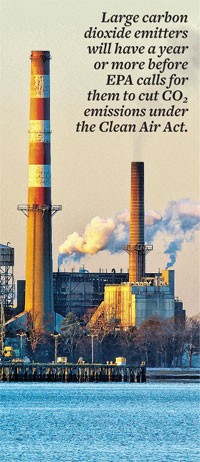Advertisement
Grab your lab coat. Let's get started
Welcome!
Welcome!
Create an account below to get 6 C&EN articles per month, receive newsletters and more - all free.
It seems this is your first time logging in online. Please enter the following information to continue.
As an ACS member you automatically get access to this site. All we need is few more details to create your reading experience.
Not you? Sign in with a different account.
Not you? Sign in with a different account.
ERROR 1
ERROR 1
ERROR 2
ERROR 2
ERROR 2
ERROR 2
ERROR 2
Password and Confirm password must match.
If you have an ACS member number, please enter it here so we can link this account to your membership. (optional)
ERROR 2
ACS values your privacy. By submitting your information, you are gaining access to C&EN and subscribing to our weekly newsletter. We use the information you provide to make your reading experience better, and we will never sell your data to third party members.
Environment
Fighting Over Clean Air
Industry attacks decades-old air pollution rules to repel greenhouse gas regulation
by Cheryl Hogue
August 2, 2010
| A version of this story appeared in
Volume 88, Issue 31

The new federal regulation of greenhouse gas emissions from cars and light trucks may not seem to have anything to do with construction of new chemical plants or major renovation of old ones. But it does, says the American Chemistry Council (ACC), a trade association of chemical manufacturers.
Specifically, the new regulations under the Clean Air Act could delay planned modifications or construction of new industrial facilities, according to Leslie Hulse, assistant general counsel for ACC. And they could mean these plants will be required to control their greenhouse gas emissions, even though the technology to do this hasn’t yet been identified, she says.
The problem is that although the Clean Air Act controls vehicle pollution and emissions from industrial plants separately, the two types of regulations are linked under this law. And those complicated connections are creating uncertainty that has ACC and other industry organizations, including the National Association of Manufacturers and the American Petroleum Institute, petitioning the Environmental Protection Agency to change its Clean Air Act regulations.
A lawyer for an environmental group, however, says the industry organizations are essentially trying to dismantle key federal protections aimed at keeping air quality from getting worse. John Walke, senior attorney for the Natural Resources Defense Council, says these Clean Air Act regulations have been in place for three decades and have gone unchallenged. Now, industry is attacking the program because “the prospect of carbon dioxide regulation is so unwelcome,” he says. /p>
Historically, EPA has not regulated CO2. But that changed in 2007 when the Supreme Court ruled that CO2 could be controlled as a pollutant under the Clean Air Act.
This high court decision set up the current situation, which started with an April rule from EPA and the National Highway Traffic Safety Administration. The rule, which is the first U.S. regulation of CO2 emissions, requires automakers to reduce emissions of greenhouse gases from vehicles beginning with the model year 2012.
But when EPA regulates a pollutant under nearly any other part of the Clean Air Act, a newly built or modified industrial facility may have to apply for a special permit and control its emissions of that pollutant.
In the Clean Air Act, Congress intended to ensure “prevention of significant deterioration” (PSD) of the air quality in regions with relatively clean air. Such locales meet the national air quality standard for any of six so-called criteria pollutants—sulfur dioxide, particulate matter, carbon monoxide, ozone, nitrogen oxides, and lead.
The law allows new and rebuilt industrial facilities in these areas to emit these and other pollutants. In some cases, plants don’t need a permit for such emissions. But in cases of new construction of large facilities that are expected to have lots of emissions or of plant renovations that will significantly increase a plant’s potential to emit most air pollutants including the criteria pollutants, a PSD permit is required.
The Clean Air Act singles out renovations or construction of chemical and pharmaceutical manufacturing plants, petroleum refineries, power plants, and several other types of industrial facilities for special scrutiny in the permit process. For these sectors, EPA regulations require any new or reconfigured facility that emits at least 100 tons per year of any pollutant controlled under the Clean Air Act to apply for a PSD permit. For other sectors, the pollution threshold for a permit is 250 tons per year.
Regulators, often at the state or local level, determine whether a company has to obtain a PSD permit before constructing or modifying a plant. A permit involves an air quality analysis and public comment. It also requires installation of what EPA calls “best available control technology.”
When EPA issued its vehicle emissions regulation, the agency determined that CO2 and other greenhouse gas emissions are part of the list of pollutants that can trigger the requirement for a PSD permit.
The agency did, however, take action to shield millions of smaller business from requirements to get permits because of their greenhouse gas emissions. In a rule released in May, EPA set new thresholds for greenhouse gas emissions: Starting in July 2011, EPA is requiring PSD permits if a new facility releases at least 100,000 tons of CO2 per year or if a modified plant boosts its CO2 emissions by at least 75,000 tons per year.
This rule could lead to major headaches for companies planning constructions or renovations, Hulse says. There is legal uncertainty about the vehicle emissions rule and the regulation setting the PSD permit thresholds for greenhouse gas releases, she points out. Both face court challenges. The cases may take years to resolve and could lead to alterations to—or possibly a court overturning—either of these rules. Although some other business groups are currently involved in those challenges, ACC isn’t.
There also remains the unresolved question over just what best available control technology would entail for CO2 released at industrial facilities, Hulse says.
In their petitions to EPA, ACC and other industry organizations are targeting rules that EPA issued in 1980 and 2002 detailing what triggers the PSD permit process. They want EPA to revise or rescind those regulations so they apply only when a source emits one of the six criteria pollutants. And they’re contending that the Clean Air Act requires PSD permits to control only the six criteria pollutants.
Walke, the environmental activist, says this argument “is utterly contradicted by 30 years of history,” reaching back to EPA’s 1980 rule. In addition, when Congress revamped the Clean Air Act in 1990, lawmakers removed one class of emissions—hazardous air pollutants—from the PSD program so they would be regulated separately. This action, Walke says, means Congress understood—and intended—that PSD controls applied to a broad range of pollutants and not just the six covered by national air quality standards.
Teresa B. Clemmer, associate professor at Vermont Law School, agrees with Walke on this point. “Congress used the extremely broad phrase ‘any air pollutant,’ ” rather than specifying the six pollutants to trigger PSD requirements, she tells C&EN.
In addition, Clemmer says, most new facilities releasing 100,000 tons of CO2 per year will also have the potential to emit other air pollutants in quantities well over the Clean Air Act thresholds for PSD permits.
Last month, ACC and the other industry groups submitted their formal petitions to EPA to change its regulations. Should the agency reject their requests, the business organizations are poised to haul the agency into federal court to specifically address the PSD permitting issue. Such judicial review could leave the regulation of industrial CO2 emissions hanging and take years to resolve.




Join the conversation
Contact the reporter
Submit a Letter to the Editor for publication
Engage with us on Twitter